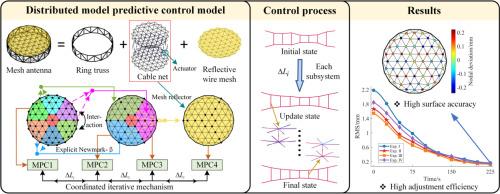Distributed active surface compensation for large space-borne mesh reflectors
IF 9.4
1区 工程技术
Q1 ENGINEERING, MECHANICAL
International Journal of Mechanical Sciences
Pub Date : 2025-09-11
DOI:10.1016/j.ijmecsci.2025.110825
引用次数: 0
Abstract
Deployable mesh reflectors in space are vulnerable to surface deviations induced by attitude adjustments, thermal cycling, and material relaxation, which affect electromagnetic performance stability. To meet the requirements of aerospace missions, a distributed active surface compensation strategy based on model predictive control and driven by micro-electromechanical actuators is proposed. A multilayer distributed subsystem model is developed based on the explicit Newmark-β method combined with dynamic substructure modeling method, enabling the formulation of subsystem-level dynamics tailored for distributed control. For each subsystem, the Newmark-β method is applied to discretize the prediction model with information interaction, and a distributed model predictive control method is developed using cable length adjustment as the driving strategy. By introducing the parametric variational principle, the actuator saturation constraint is reformulated as a linear complementarity problem, enabling efficient active surface error compensation. Numerical simulations show that the proposed method is adaptable to different shape adjustment scenarios and the ability to maintain the surface accuracy under sub-controller failures, demonstrating both stability and fault-tolerance. Furthermore, a closed-loop active surface compensation experimental verification system is also built based on the 3-meter-diameter mesh reflector prototype, and the shape adjustment experiments show a real-time surface error reduction of over 90%. These results confirm the practical feasibility and control effectiveness of the proposed distributed model predictive control approach, achieving real-time error compensation and verifying its applicability for large flexible space mesh structures.

大型星载网格反射器的分布式主动曲面补偿
空间中可展开的网状反射器容易受到姿态调整、热循环和材料松弛引起的表面偏差的影响,从而影响电磁性能的稳定性。针对航天任务的要求,提出了一种基于模型预测控制、微机电作动器驱动的分布式主动曲面补偿策略。基于显式Newmark-β方法,结合动态子结构建模方法,建立了多层分布式子系统模型,实现了适合分布式控制的子系统级动力学模型的构建。针对各子系统,采用Newmark-β方法对预测模型进行信息交互离散化,建立了以电缆长度调整为驱动策略的分布式模型预测控制方法。通过引入参数变分原理,将执行器饱和约束重新表述为线性互补问题,实现了有效的主动曲面误差补偿。数值仿真结果表明,该方法能够适应不同的形状调整场景,并能在子控制器失效的情况下保持曲面精度,具有较好的稳定性和容错性。在此基础上,建立了基于3 m直径网格反射镜原型的闭环主动曲面补偿实验验证系统,形状调整实验结果表明,该系统可将曲面误差实时降低90%以上。这些结果验证了所提出的分布式模型预测控制方法的实际可行性和控制有效性,实现了实时误差补偿,验证了该方法对大型柔性空间网格结构的适用性。
本文章由计算机程序翻译,如有差异,请以英文原文为准。
求助全文
约1分钟内获得全文
求助全文
来源期刊

International Journal of Mechanical Sciences
工程技术-工程:机械
CiteScore
12.80
自引率
17.80%
发文量
769
审稿时长
19 days
期刊介绍:
The International Journal of Mechanical Sciences (IJMS) serves as a global platform for the publication and dissemination of original research that contributes to a deeper scientific understanding of the fundamental disciplines within mechanical, civil, and material engineering.
The primary focus of IJMS is to showcase innovative and ground-breaking work that utilizes analytical and computational modeling techniques, such as Finite Element Method (FEM), Boundary Element Method (BEM), and mesh-free methods, among others. These modeling methods are applied to diverse fields including rigid-body mechanics (e.g., dynamics, vibration, stability), structural mechanics, metal forming, advanced materials (e.g., metals, composites, cellular, smart) behavior and applications, impact mechanics, strain localization, and other nonlinear effects (e.g., large deflections, plasticity, fracture).
Additionally, IJMS covers the realms of fluid mechanics (both external and internal flows), tribology, thermodynamics, and materials processing. These subjects collectively form the core of the journal's content.
In summary, IJMS provides a prestigious platform for researchers to present their original contributions, shedding light on analytical and computational modeling methods in various areas of mechanical engineering, as well as exploring the behavior and application of advanced materials, fluid mechanics, thermodynamics, and materials processing.
 求助内容:
求助内容: 应助结果提醒方式:
应助结果提醒方式:


